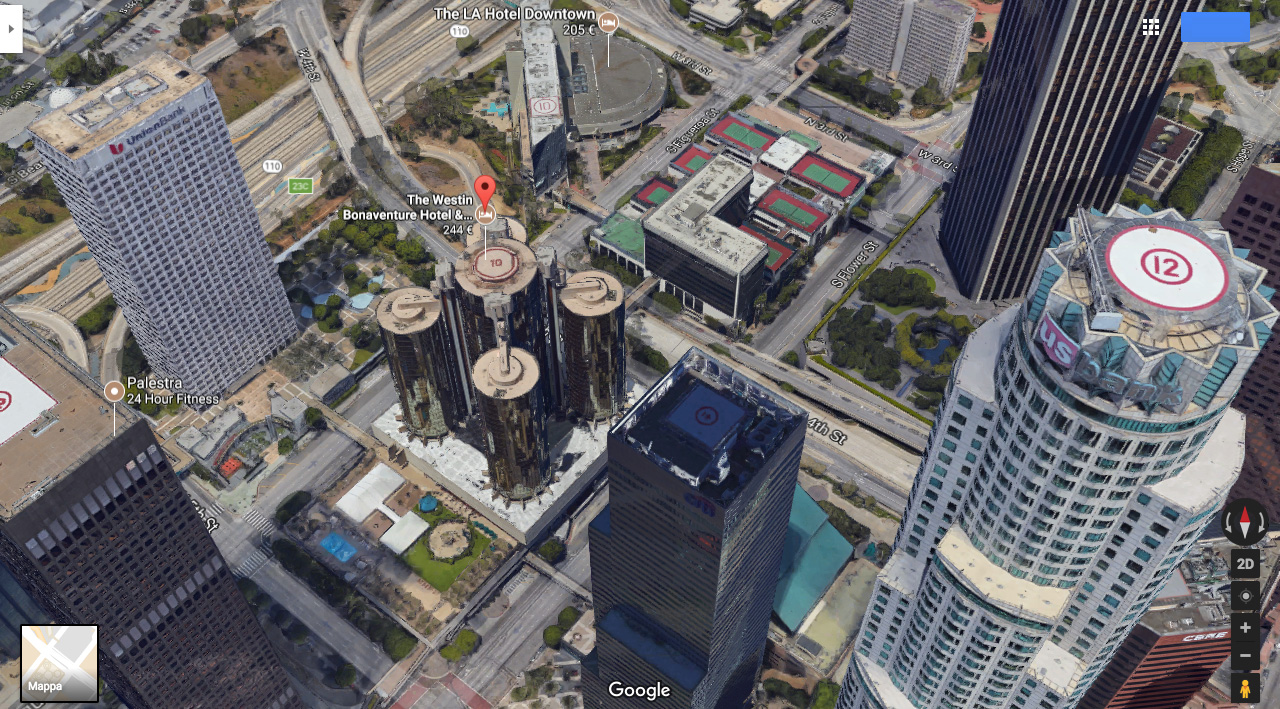42
Westin Bonaventure Hotel
Author: John Portman
Year: 1976 Edit Add
Book: Postmodernism, or, The Cultural Logic of Late Capitalism
Westin Bonaventure Hotel
Author: John PortmanYear: 1976 Edit Add
Book: Postmodernism, or, The Cultural Logic of Late Capitalism
This diagnosis is confirmed by the great reflective glass skin of the Bonaventure, whose function I will now interpret rather differently than I did a moment ago when I saw the phenomenon of reflection generally as developing a thematics of reproductive technology (the two readings are, however, not incompatible). Now one would want rather to stress the way in which the glass skin repels the city outside, a repulsion for which we have analogies in those reflector sunglasses which make it impossible for your interlocutor to see your own eyes and thereby achieve a certain aggressivity toward and power over the Other. In a similar way, the glass skin achieves a peculiar and placeless dissociation of the Bonaventure from its neighborhood: it is not even an exterior, inasmuch as when you seek to look at the hotel's outer walls you cannot see the hotel itself but only the distorted images of everything that surrounds it. Now consider the escalators and elevators. Given their very real pleasures in Portman, particularly the latter, which the artist has termed "gigantic kinetic sculptures" and which certainly account for much of the spectacle and excitement of the hotel interior -- particularly in the Hyatts, where like great Japanese lanterns or gondolas they ceaselessly rise and fall -- given such a deliberate marking and foregrounding in their own right, I believe one has to see such "people movers" ( Portman's own term, adapted from Disney) as somewhat more significant than mere functions and engineering components. We know in any case that recent architectural theory has begun to borrow from narrative analysis in other fields and to attempt to see our physical trajectories through such buildings as virtual narratives or stories, as dynamic paths and narrative paradigms which we as visitors are asked to fulfill and to complete with our own bodies and movements. In the Bonaventure, however, we find a dialectical heightening of this process: it seems to me that the escalators and elevators here henceforth replace movement but also, and above all, designate themselves as new reflexive signs and emblems of movement proper (something which will become evident when we come to the question of what remains of older forms of movement in this building, most notably walking itself). Here the narrative stroll has been underscored, symbolized, reified, and replaced by a transportation machine which becomes the allegorical signifier of that older promenade we are no longer allowed to conduct on our own: and this is a dialectical intensification of the autoreferentiality of all modern culture, which tends to turn upon itself and designate its own cultural production as its content.
This diagnosis is confirmed by the great reflective glass skin of the Bonaventure, whose function I will now interpret rather differently than I did a moment ago when I saw the phenomenon of reflection generally as developing a thematics of reproductive technology (the two readings are, however, not incompatible). Now one would want rather to stress the way in which the glass skin repels the city outside, a repulsion for which we have analogies in those reflector sunglasses which make it impossible for your interlocutor to see your own eyes and thereby achieve a certain aggressivity toward and power over the Other. In a similar way, the glass skin achieves a peculiar and placeless dissociation of the Bonaventure from its neighborhood: it is not even an exterior, inasmuch as when you seek to look at the hotel's outer walls you cannot see the hotel itself but only the distorted images of everything that surrounds it. Now consider the escalators and elevators. Given their very real pleasures in Portman, particularly the latter, which the artist has termed "gigantic kinetic sculptures" and which certainly account for much of the spectacle and excitement of the hotel interior -- particularly in the Hyatts, where like great Japanese lanterns or gondolas they ceaselessly rise and fall -- given such a deliberate marking and foregrounding in their own right, I believe one has to see such "people movers" ( Portman's own term, adapted from Disney) as somewhat more significant than mere functions and engineering components. We know in any case that recent architectural theory has begun to borrow from narrative analysis in other fields and to attempt to see our physical trajectories through such buildings as virtual narratives or stories, as dynamic paths and narrative paradigms which we as visitors are asked to fulfill and to complete with our own bodies and movements. In the Bonaventure, however, we find a dialectical heightening of this process: it seems to me that the escalators and elevators here henceforth replace movement but also, and above all, designate themselves as new reflexive signs and emblems of movement proper (something which will become evident when we come to the question of what remains of older forms of movement in this building, most notably walking itself). Here the narrative stroll has been underscored, symbolized, reified, and replaced by a transportation machine which becomes the allegorical signifier of that older promenade we are no longer allowed to conduct on our own: and this is a dialectical intensification of the autoreferentiality of all modern culture, which tends to turn upon itself and designate its own cultural production as its content.
 Log-in
Log-in Source type: picture
Source type: picture